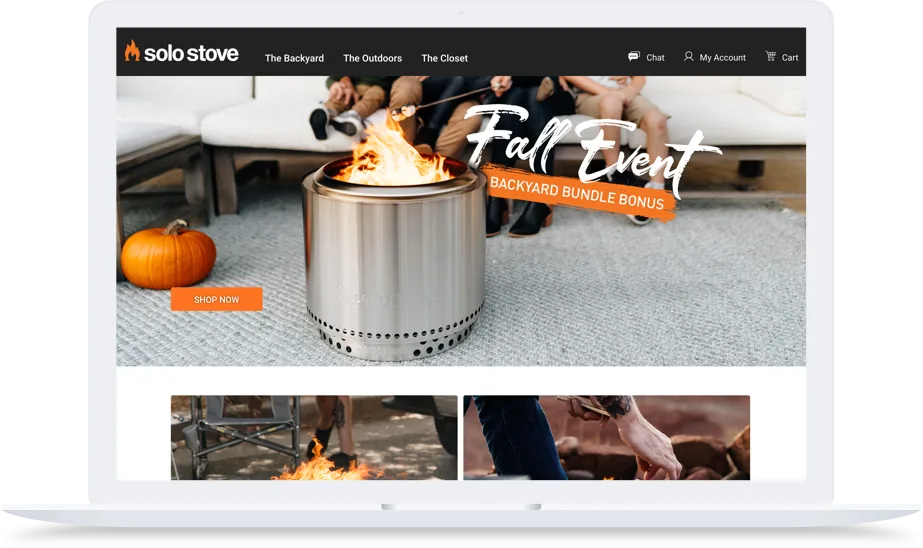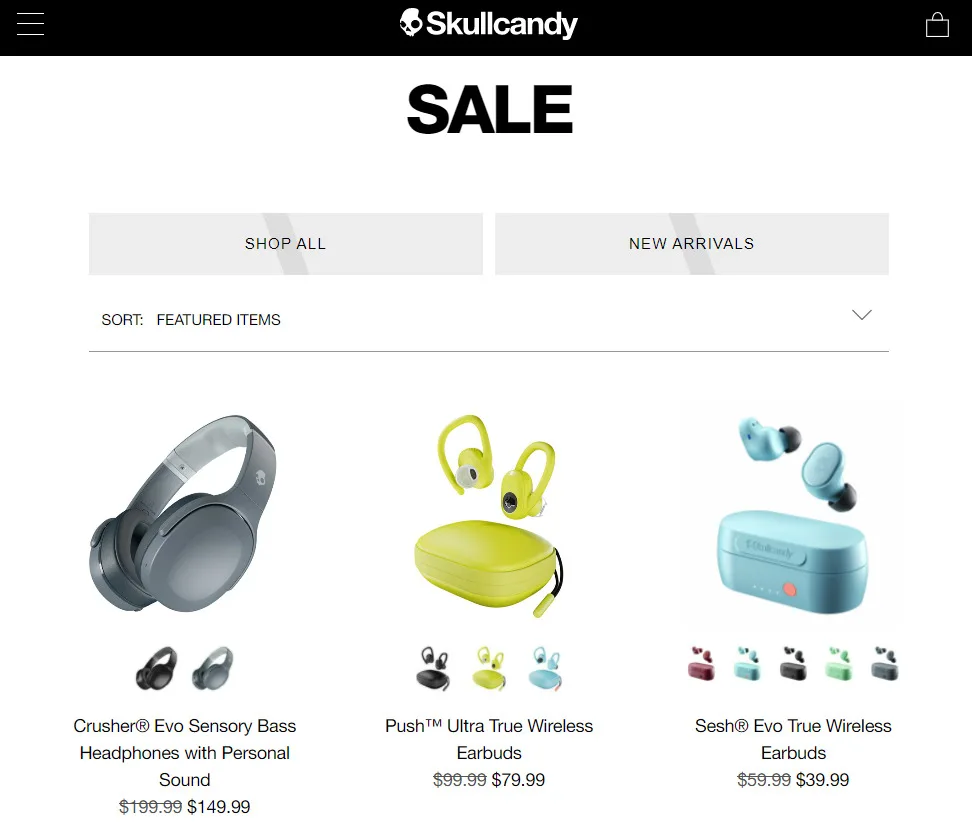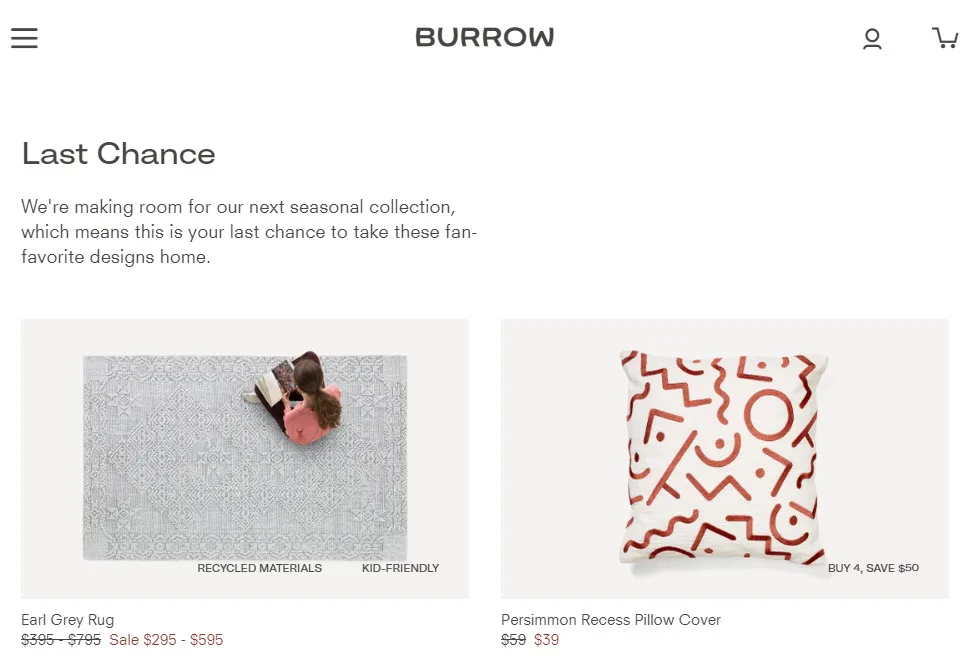How to Use Surplus Inventory to Boost Online Sales

Knowing what to do with surplus inventory is a problem most business owners and ecommerce managers face at some point. All those products still piled up in your storage space are costing you time, and money that could be better spent focusing on the next season’s top-selling products.
But remember, all retailers and ecommerce brands face excess inventory from time to time, and knowing how to get rid of old products is an essential part of any operation. With some smart choices the stress of excess inventory will soon be a thing of the past.
Identifying the causes of your excess stock is the first step in managing the problem. Once you’ve done this, you’ll be able to avoid accumulating too much surplus in the future and get your existing surplus inventory moving off the shelves in no time.
In this article, we want to help you get a handle on your store inventory now and for the future. A poorly managed surplus can bring mounting costs, negatively affect in-store and online conversions, and stifle your cash-flow.
There’s never been a more apt moment to be discussing this growing phenomenon. Since the pandemic began, the expected value of excess inventory has soared above global averages. For instance, in the fashion industry, the excess from Spring/Summer 2020 reached between $160 and $185 billion worldwide. That’s over double what was expected and planned for.
Luckily, there are plenty of strategies that can reduce or even negate this common problem. From shifting current stock to demand forecast optimization, keep reading to find out everything you need to get on top of your inventory controls.
What Is Excess or Surplus Inventory?
In simple terms, surplus inventory is excess stock. Some companies will hold excess inventory on purpose, as a sort of ‘back up’ supply in case demand is higher than expected. But, more often than not, excess inventory is the result of overstocking due to poor demand forecasting.
Sometimes ordering a consignment with a small amount of excess or surplus inventory can be useful – for instance, if you’re anticipating a seasonal sales spike. However, chronic overstocking can very quickly become a major drain on resources.
Inventory costs. It takes up space and money in storage, and sometimes businesses even end up footing the bill for disposing of excess stock. Furthermore, for those who sell perishable goods, there’s the added problem of expiry dates.
What Causes Surplus Inventory?
There are many reasons why a business may end up holding onto surplus items. Sometimes inaccurate demand forecasting is simply a matter of oversight, but in other instances, external factors and socio-economic markers may be at play.
First, let’s talk about forecasting errors. Inadequate forecasting methods, ignoring seasonality, and a lack of basic market understanding are some of the major causes of forecasting error. More often than not, poor inventory planning happens because businesses don’t have the right tools. Luckily, there’s some top inventory management software out there today that will track, manage, and organize all of your inventory and sales orders in one place.
But, as previously mentioned, sometimes businesses end up with excess inventory for reasons that seem totally out of their control. Every product has a lifecycle, and demand for the said product will naturally peak and decline. Likewise, businesses that have very complex supply chains with multiple locations may struggle to centralize their inventory management – ending up with far more stock than they can shift. In such cases, it’s essential to demarcate key roles and responsibilities and utilize the appropriate tech to oversee your large operation.
To top things off, when socio-political events (think of Brexit in the UK, for example) threaten market stability, companies are forced to over-order for contingency purposes. When surplus property grows out of control, it can be really bad for business.
Why having surplus inventory is bad for business
But why is all this spare inventory such a bad thing? Surely it’s good to have extra products to sell?
Well, not always.
Unless that extra stock is serving a purpose (a.k.a being sold), it festers and grows into a resource drain, taking up space, costing money in storage, depreciating in value, and tying up financial capital in stationery products on shelves. When a business overstocks on a regular basis they are more likely to encounter space problems in-store. Lingering stock prevents retailers from placing new-season items on the rails, restricting sales opportunities.
As old products depreciate in value (maybe even becoming obsolete or spoiled), new products are denied the space and attention they deserve. That means reduced profits for the quarter as that excess inventory must be slashed down in price in order to shift it at all. In the worst-case scenario, some companies will resort to selling their products below the purchase price and thus incur a loss. Mobilizing multi-channel retail software is the best way to regain control over even the most complex of supply chains. Retail solutions centralize and automate all retail processes from purchasing to inventory, warehousing, shipping, and more.
However, there are ways to avoid surplus inventory affecting your bottom line. Instead, make it work for you by boosting your online sales.
How to Use Surplus Inventory to Boost Online Sales
We’ve established that too much surplus inventory is less than ideal. It’s eating away at your profit margins and taking up space in the meantime. But there’s no point dwelling on the negatives. We’re here to provide positive, actionable solutions. Let’s turn the problem on its head and discuss how we can use our surplus inventory to boost online retail sales.
1. Create bundled deals.
Ever come across an enticing bundle deal when shopping online? Did it catch your attention? Sure it did. Bundled deals are a great way to shift products that are otherwise just accumulating dust. It’s a win-win – your customers grab a bargain and you shift those hard-to-budge items. But how can you create the best bundle deal out there?
The best bundle deals leave everyone feeling satisfied. Instead of lumping your customers with a bundle of deadstock, combine your older products with enticing new ones to attract new customers. Try to bundle multiple products of the same (or similar) type. For example, a bundle of bath products, or a gaming bundle combining one new release with a collection of older games.
This method helps you engage more customers and liquidate your assets. Especially around the holidays, shoppers are looking out for these bundle-style offerings as they make excellent gifts. Here are some promotional ideas to get your new product bundle flying off the shelves at full velocity.
Combine older and newer products
Combine popular and less popular products
Curate bespoke product collections
Offer a free product with your bundle
Run a prize promotion or giveaway
Here’s a practical example. Di Bruno Bros is a specialty cheese retailer based in the U.S offering customers fine cheeses, cured meats, and other specialty foods. Di Bruno Bros’ products are perishable, so they have to manage their inventory (and any surplus) with precision. By navigating their website, you’ll notice that this company uses the bundle-method expertly, promoting curated gift boxes, and 2 for $10 bundle promotions. The image below shows a themed bundle – in this case, a coffee break gift box.

Image from Di Bruno Bros
2. Refresh your marketing and display strategy.
Another great way to get that stock moving online is with a marketing refresh. Whether you’re outsourcing to a third-party marketer or have your own marketing team in-house, it’s important to communicate your amazing offers with some savvy marketing strategies.
That could mean anything from a killer email marketing campaign to strategic product placement on your ecommerce website. Just make sure that you’re placing those offers where your customers will find them (and buy them).
Think outside the box and offer your customers something that your competitors are not. How about curbside pick up operations, for example, or free delivery?
Make sure you don’t only focus on your ecommerce store. Get the message out on your website, social media channels, newsletters, and emails. Post about it, tweet about it, Instagram it, and don’t forget to include some enticing images for more conversions. Holiday seasons are an ideal time to do a little extra promotion, as everyone will be on the lookout for the perfect gift – take a look at the example from Larq below.

Planning your marketing strategies ahead of time helps you get a grasp of how to properly market your products based on your needs. Take the time advantage of retail calendars or process mapping to create cohesive plans
3. Highlight them on your website.
Highlight the products you need to shift on your website. The key is to drive attention to these items in whatever way possible. It could be by placing a promotion on your homepage, highlighting items as ‘last chance to buy’, or ensuring they show up near the top of search results.
You could even offer free shipping on these particular products. A combination of visual appeal and enticing promotion is the best way to draw attention to your excess inventory online. Remember your customers don’t know that these products are your nemesis.
Good website design can shift products. Aim for attractive color schemes, high-quality images, and creative, informative content that sells itself. Adding new keywords and descriptions alone can work wonders.
If that’s not doing it, why not try writing a post about it on your company blog, or dedicating a section in your newsletter to them? Accessibility and visibility are the aim of the game. This way you’ll be able to turn all that deadstock into appealing merchandise for your customers.
4. Make use of your social media and digital marketing campaign.
Don’t forget about content marketing and social media. The right blog post, tweet, Instagram picture, LinkedIn post, or email could be enough to pick up those sales.
Of course you shouldn’t dismiss the power of a good old-fashioned email marketing campaign. With enticing SEO optimized content, the perfect offer, and a killer CTA, you’ll get your customers buying up all your excess inventory in no time at all.
One company that has got this right already is Solo Stove. This outdoor lifestyle retailer has experienced some serious business growth in recent years with a 50% increased conversion rate year on year. And a big part of their success comes from targeted emailing.
Solo Stove uses targeted emailing to reach more customers and it’s working. 20% of the company’s overall revenue now comes from marketing campaigns involving email.

5. Implement a discount strategy.
Eventually, you’ll need to start discounting your surplus stock to keep things moving and free up shelf space. If you want to move your stock super quickly, why not try holding a limited-time flash sale? There’s nothing like the fear of missing out to drive people to action and get people spending.
Of course, there’s no need to slash your prices all at once. Instead, you could practice incremental discounting starting with a small reduction of five or ten percent, and gradually increasing the reduction as time goes on to 20%, 30%, etc. Once you find your reduction sweet spot, you can add more stock at that price.
Make sure it’s easy for your customers to find these reductions, too. Take SkullCandy, for example. If you check out the SkullCandy website, you’ll find a designated section for sale items only, where users can find discounted price products.

6. Use clearance sales.
Everyone loves a good bargain. Similar to your discount strategy, a full-on clearance sale will draw in those sales shopaholics from far and wide. A clearance sale is one of the very best asset liquidation strategies out there.
Clearance sales are often even more effective than one-off discounts. That’s because the type of customer that visits a clearance sale (whether in-store or online) is actively intending to buy last-season, discounted products. When you group lots of these products together that creates great potential for revenue creation.
Another option is bulk sales. Bulk sales require consumers to buy a minimum number of items (and often offer a free item in return for this transaction). They’re a great method for shifting perishable goods with a shorter shelf-life, gifting sets, and fashion items.
Depending on how much stock you have to shift, you can choose to approach a clearance sale in two ways. First, you might want to plan a limited-time event, send out some dedicated email marketing beforehand, and hope to shift a truckload of products. Alternatively, you might prefer to include a Last Chance to Buy page on your website. Check out this example by home retailer Burrow.

7. Include surplus as freebies.
We all like getting something for free – so take advantage of this. Freebies are a great option for low-cost items that have proven themselves to be particularly slow-moving. But remember, you’re not doing this out of the goodness of your own heart.
This type of free giveaway is entirely tactical. You need to use free items as an incentive for present or future purchases (by getting customers to spend a certain amount on your online store or sign up for your mailing list).
For example, these are some great freebie promotion ideas:
Spend $50 in store and get a free wallet
Sign up to our mailing list and get a free bag
Spend $40 on a particular beauty brand, and get an exclusive perfume
The aim is to give your customers something and receive something that benefits your in-store or online business in return, thus offsetting any costs incurred by giving away surplus inventory free of charge.
8. Motivate your team members to sell them faster.
Sometimes you need more than offers to get stock moving. Sometimes you need the human touch. Your staff’s attitude can make a huge difference to sales. That’s why it’s so important to prioritize top talent acquisition and company culture. When you’ve got products that need moving (and pronto), you’ll need a team by your side that can sell, sell, sell.
It’s not just in store, either. Online retailers can make use of their call center reps to push through sales and encourage cross-selling. Offering bonuses for selling this extra stock can help too – if you have multiple physical locations, maybe the store that sells the most gets an extra day off? Or when your call center team hits a certain amount, they get a free lunch.
Today’s call center technology trends have advanced a lot. These days, customers benefit from multiple channels of customer support with their online retailers. That could be via chatbot, live chat, email, social media, or phone call. So make sure your offers and promotions aren’t left out of these conversations.
9. Sell the stock to a distributor.
In some cases, it’s not necessary to shift excess inventory to paying customers. Sometimes it is also possible to resell leftover inventory back to your vendor, in return for credit or newer merchandise. Make sure to keep that inventory in tip-top condition.
Likewise, if products aren’t shifting on your own website, there’s nothing stopping you from turning to online marketplaces like eBay and Amazon, or even liquidators who will buy surplus stock from you (although, admittedly, for a much lower price point).
10. Promote them with pop-up shops.
These days, pop-up shops and boutiques are all the rage. Pop-up shops and developments are on the rise in major cities like New York, L.A, and London. Customers flock to these locations to discover new brands and pick up a bargain.
These semi-permanent business premises host brands for a limited time only, to increase brand awareness and test out market responsiveness. But they’re also a great way to move excess products.
The limited-time nature of a pop-up creates a sense of transactional urgency and customers know that the products on sale won’t be around forever. It’s now or never.
11. Donate them.
Finally, it’s true that (sometimes) stock just won’t budge. When this happens, a donation is the best course of action. You’ll free up space on your shelves and contribute to a good cause at the same time.
Some ecommerce businesses will donate to charity establishments, nonprofits, and homeless shelters, whilst others might choose to host a charity event. Both options are sound, though the latter also offers additional potential for building brand awareness.
How to Avoid Surplus Inventory
We’ve spoken all about what to do with that dreaded extra inventory. But what about avoiding the whole ordeal in the first place? Instead of going into crisis mode every time you’ve got deadstock to shift, how about never having deadstock in the first place.
Yes, it is possible.
The key to avoiding surplus inventory buildup is to only order the products that you know you are going to use or need. That involves precision planning and forecasting based on historical sales data and projected trends, seasons, and events to come.
When forecasting inventory, it’s important to also factor in lead times meaning the amount of time between purchase and replenishment.
Depending on the size and scale of your business, whether you’re a small business startup or a multichannel retailer, manual forecasting is usually pretty precarious. When multiple online sales channels, offline stores, and storage locations are at play, inventory management becomes far more complicated. But with the right tools, it’s eminently possible.
Here are some top tips for avoiding surplus stock for good.
1. Find weak spots in your customer research.
Look back on past customer research. Was it up to scratch? Customer research should be the foundation of your demand and inventory planning. So find those weak points and fix them. Perhaps you’ve been aiming your products at the wrong demographic, or choosing ineffective marketing strategies.
Once you get your customer research right, the rest will follow. Start by focusing on both quantitative and qualitative methods such as interviews, surveys, and focus groups. These will help you understand who your customers are, and what it is they want. You may then use your updated customer research to anticipate big-picture demand trends.
Check you’re up to date on the most relevant methods, too. According to Statista, as of 2020, mobile-first surveying was found to be the most used emerging research approach in the market research industry worldwide. 64% of the study’s respondents stated that they used mobile-first surveys to conduct research.
Finally, make sure you’ve got the right tools. Inventory management software will manage your entire backend, and the best POS system will integrate with this. This will help you accept payments but also provide much-needed sales analytics, inventory management, and customer data to inform future orders.
2. Take extra caution when researching customer demand.
When researching customer demand, there are numerous factors that must be taken into account. Accurate demand forecasting is the backbone of successful inventory management and the best way to avoid over-ordering and excess stock.
An effective demand plan will help you improve inventory management, supply chain visibility, and customer experience as a result. As part of your market research make sure to take into account the following data:
Historical sales data
Seasonal sales trends
Localized sales data
Third-party data
Take the year 2020, for example. The pandemic changed everything. As such, customer demand changed too. The online share in grocery sales is now set to double over the next five years. And that will have to inform the demand forecasts of businesses far and wide.
3. Use technology to improve the ordering process.
Never underestimate the importance of accurate ordering. Manual sales order processes often result in human errors. But using the right tools and software to manage your purchase order template can radically reduce the risk of miscalculating stock orders.
Today’s sales order automation tools use real-time data, KPIs, and precision metrics to automatically re-order stock when your inventory levels reach a designated reorder point. That means there’s no need to overstock on contingency but you’ll also never be in an out-of-stock situation either.
Wave Goodbye to Surplus Inventory
Don’t let surplus inventory bog you down any longer. With the right strategy, you’ll be able to shift your existing overstock and reduce surplus in the future. With prior planning, and the right tools in tow, you’ll have your business under control from frontend to backend, and make that hard-to-move inventory a thing of the past.

Xiao is the Director of global demand generation at Brightpearl, a leading retail operations platform. She is passionate about setting up innovative strategies to grow sales pipelines using data-driven decisions.


